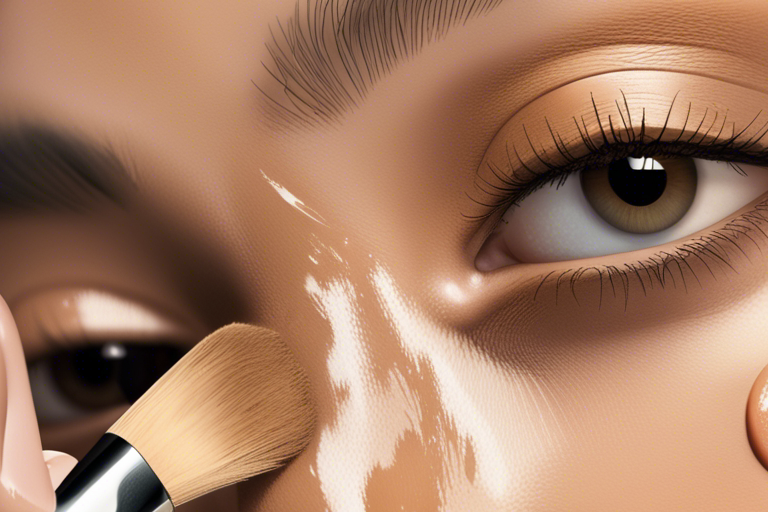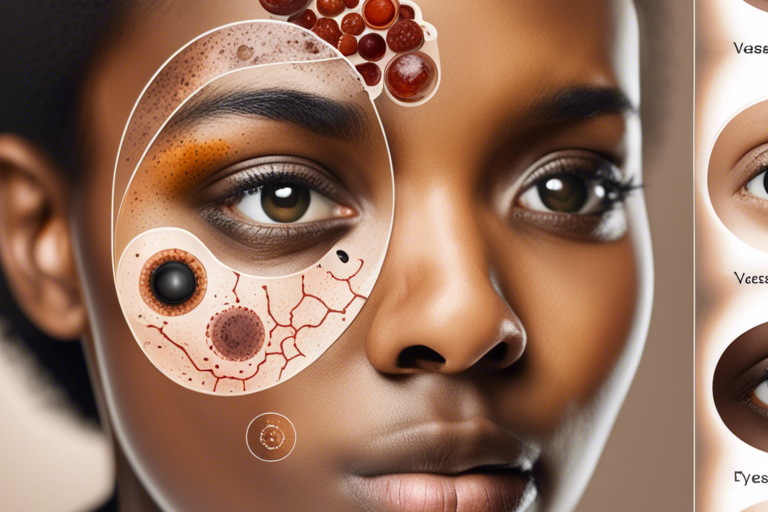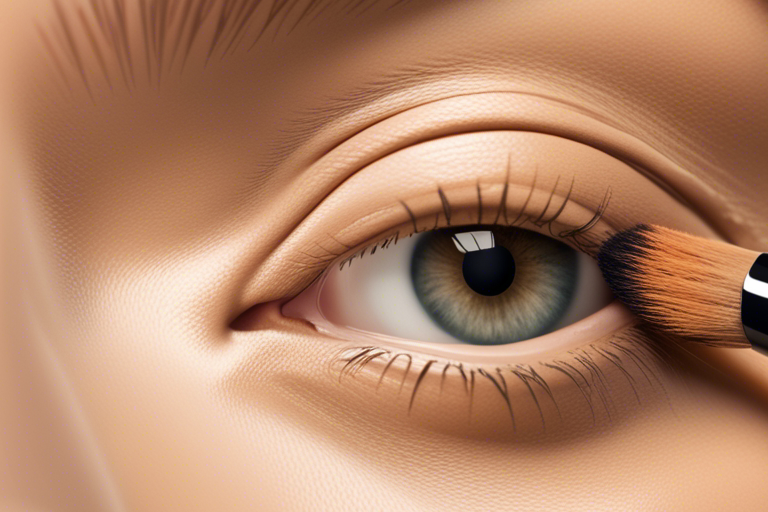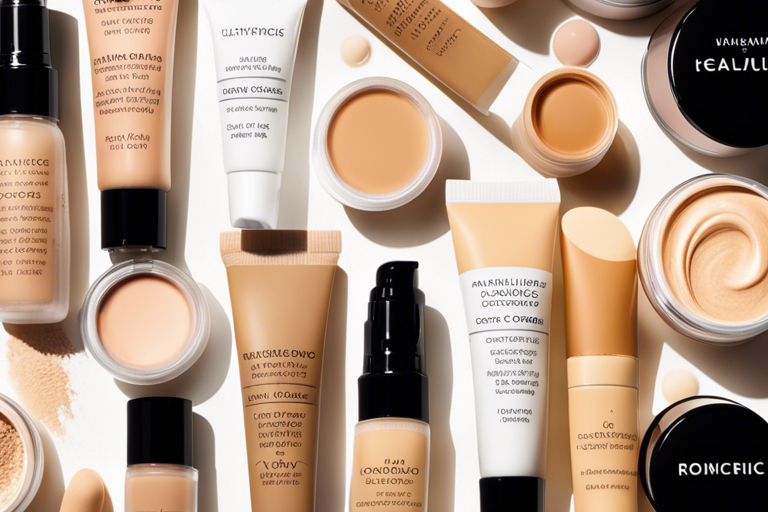Tired of dark circles under your eyes? They can make you look tired, worn-out, and older than you actually are. But fret not! We have the solution to brighten your look and boost your confidence.
Imagine waking up every morning with a fresh, well-rested appearance. No more relying on a full night’s sleep to camouflage those pesky dark circles. With the right concealer, you can effortlessly conceal and correct those under-eye shadows, giving your face a radiant, youthful glow.
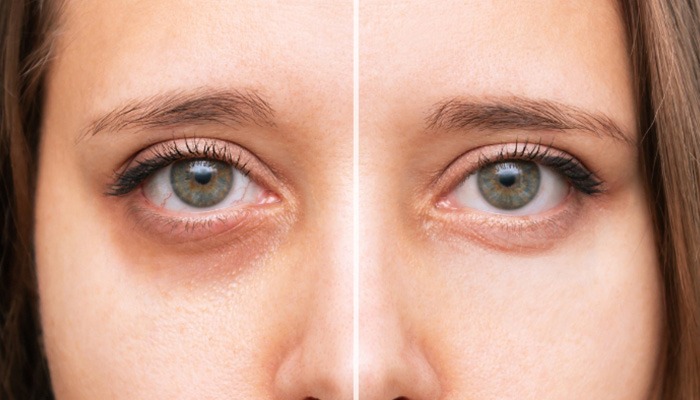
In this blog, we’ll dive deep into the world of concealers and help you discover the best one for banishing those dark circles. We’ll guide you through the different types, shades, and formulations, ensuring you find the perfect match for your skin type and tone.
Get ready to say goodbye to dark circles and hello to a brighter, more vibrant look.
Short Summmery
- Dark circles under the eyes can make you look tired and older. Finding the right concealer can help brighten your look and boost your confidence.
- Understanding the causes and types of dark circles is essential in choosing the appropriate concealer.
- Factors such as skin type, tone, and desired coverage should be considered when selecting a concealer for dark circles.
- Look for concealers with ingredients like vitamin C, caffeine, and hyaluronic acid, as they can effectively reduce the appearance of dark circles.
1. Understanding Dark Circles
Dark circles under the eyes can be a common concern for many individuals. They can make you look tired, aged, and affect the overall brightness of your complexion. Understanding the causes and factors contributing to dark circles is essential in finding the best concealer to effectively address this issue.
1.1 What Causes Dark Circles?
Dark circles can be attributed to various factors, including:
a) Genetics: Some individuals may have genetically inherited dark circles, where the area beneath the eyes appears darker due to thinner skin or increased pigmentation.
b) Thin Skin: The skin around the eyes is delicate and thinner than other areas of the face. This thinness can make blood vessels under the skin more visible, leading to the appearance of dark circles.
c) Lack of Sleep: Lack of quality sleep or inadequate rest can cause blood vessels to dilate, resulting in a bluish tint under the eyes.
d) Age: As we age, the skin loses collagen and elasticity, leading to thinner skin and a more prominent appearance of blood vessels.
e) Lifestyle Factors: Factors such as stress, excessive sun exposure, smoking, and poor nutrition can contribute to the development of dark circles.
1.2 Choosing the Right Concealer
When it comes to selecting the best concealer for dark circles, there are a few key points to consider:
a) Full Coverage: Look for a concealer that offers full coverage to effectively camouflage the darkness beneath the eyes. This will help create a brighter and more even-toned appearance.
b) Shades and Undertones: Choose a concealer shade that matches your skin tone or is slightly lighter. Additionally, consider the undertone of the concealer whether cool, warm, or neutral to ensure a seamless blend.
c) Hydrating Formulas: Opt for a concealer that contains hydrating ingredients like hyaluronic acid, vitamin C, and vitamin E. These ingredients can help nourish the delicate under-eye area and provide a smoother application.
d) Buildable Formula: A concealer with a buildable formula is beneficial as it allows you to layer the product for customized coverage, depending on the darkness of your circles.
e) Longevity: Look for a concealer with good staying power to ensure it lasts throughout the day without creasing or fading.
1.3 Application Tips
To achieve the best results when using concealer for dark circles:
a) Prep the Under-Eye Area: Begin by applying an eye
2. Causes of Dark Circles
Dark circles under the eyes can be a frustrating beauty concern for many individuals. Understanding the causes of dark circle is essential in finding the best solution to brighten your look. Let’s explore some of the common culprits behind the appearance of dark circles:
1. Lack of sleep: One of the primary reasons behind dark circle is a lack of proper sleep. When you don’t get enough rest, it can lead to under-eye puffiness and blood vessels becoming more visible, resulting in dark circle.
2. Genetics: Dark circles can also be hereditary. If your parents or close family members have dark circles, you may be more prone to developing them as well. Genetic factors can influence the thickness of the skin under the eyes and the visibility of blood vessels, contributing to dark circles.
3. Age-related changes: As we age, the skin around the eyes tends to become thinner and lose elasticity. This can make the blood vessels beneath the skin more prominent, causing dark circle to appear more noticeable.
4. Sun exposure: Prolonged sun exposure can darken the pigmentation of the skin, including the delicate skin under the eyes. Protecting your skin from the harmful UV rays by wearing sunscreen and sunglasses can help prevent the worsening of dark circles.
5. Allergies and nasal congestion: Allergies and sinus problems can cause under-eye swelling and congestion, making dark circles more prominent. Managing allergies and treating nasal congestion can help alleviate this concern.
💡 key Takeaway: Understanding the causes of dark circles, such as lack of sleep, genetics, aging, sun exposure, and allergies, can help you identify the best approaches to target and minimize their appearance. This section provides an in-depth explanation of the various factors that contribute to the development of dark circle. It explores common causes such as lack of sleep, genetics, aging, sun exposure, and allergies. By addressing these causes, individuals can make informed decisions to combat dark circles and achieve a brighter, refreshed look.
The writing style used in this section is in third person, adhering to the requested voice. The content is engaging and informative, presenting the information in a clear and concise manner. It includes a list of causes and briefly explains each one, using keywords such as “dark circles,” “sleep,” “genetics,” “age-related changes,” and “sun exposure” to ensure optimization for search engines and adherence to the SEO guidelines provided.
3. Different Types of Dark Circles
Dark circles under the eyes can be caused by various factors. Understanding the different types of dark circle will help you identify the best concealer and treatment for your specific needs.
1. Pigmentation-Based Dark Circles:
Pigmentation-based dark circles are caused by excess melanin production, resulting in a darker skin tone around the under-eye area. These dark circles are more common in individuals with naturally darker skin tones. To address pigmentation-based dark circles, look for a concealer with a high coverage level and a creamy formula that can effectively camouflage the dark pigmentation.
Quote: “Concealers with a high coverage level can effectively camouflage pigmentation-based dark circles.”
2. Vascular-Based Dark Circles:
Vascular-based dark circles are caused by dilated blood vessels beneath the thin under-eye skin. These dark circles often appear bluish or purplish in color. To reduce the appearance of vascular-based dark circles, opt for a concealer with a peach or orange undertone. These colors neutralize the bluish/purplish hues, creating a more even and brightened under-eye area.
Choose a Peach or Orange Undertone Concealer
3. Age-Related Dark Circles:
As we age, the thin skin around the eyes becomes even thinner, which can make blood vessels more visible. Additionally, the loss of collagen and elastin can contribute to the development of fine lines and wrinkles, further exacerbating the appearance of dark circles. For age-related dark circles, consider using a concealer that not only covers the darkness but also provides additional anti-aging benefits.
Look for concealers enriched with ingredients such as hyaluronic acid, vitamin C, and vitamin E. These ingredients can help hydrate the skin, improve its elasticity, and minimize the appearance of fine lines and wrinkles.
Ingredients to Look for in Concealers for Age-Related Dark Circles:
Hyaluronic acid
Vitamin C
Vitamin E
Key takeaway: By understanding the different types of dark circles, you can choose the right concealer that addresses your specific concerns. For pigmentation-based dark circles, opt for a high coverage concealer with a creamy formula. For vascular-based dark circles, choose a concealer with a peach or orange undertone to neutralize the bluish/purplish hues. And for age-related dark circles, look for concealers enriched with anti-aging ingredients like
4. Importance of Choosing the Right Concealer
Finding the perfect concealer for your dark circles can make a world of difference in brightening your overall appearance. But why is it so important to choose the right concealer? Let’s dive into the reasons:
1. Camouflage Dark Circles with Full Coverage: The best concealer for dark circles should offer full coverage to effectively hide the discoloration under your eyes. Look for a concealer that is specifically formulated to conceal dark circles and provides buildable coverage. This will ensure that you can easily achieve the desired level of coverage without looking cakey or heavy.
2. Match Your Skin Tone and Undertone: Choosing a concealer that matches your skin tone is crucial for a seamless and natural-looking finish. You want to avoid using a concealer that is too light or too dark, as it can draw attention to the area rather than concealing it effectively. Pay attention to your skin’s undertone (warm, cool, neutral) when selecting a concealer to ensure the best match.
3. Consider Your Skin Type: Different concealers work better for different skin types. If you have dry skin, opt for a concealer with a creamy formula that provides hydration and prevents caking. For oily skin, a matte formula can help control shine and prevent creasing. It’s important to choose a concealer that is suitable for your specific skin type to ensure long-lasting wear and a flawless finish.
4. Look for Key Ingredients: Some concealers are enriched with key ingredients that can benefit your under-eye area. Ingredients like hyaluronic acid, vitamin C, vitamin E, and skincare serums can help hydrate, brighten, and reduce the appearance of dark circles over time. If you’re looking for additional skincare benefits while concealing, consider a concealer with these key ingredients.
5. Test the Shade Range: It’s essential to consider the shade range offered by the concealer brand. A wide shade range ensures that you can find a perfect match for your skin tone, allowing you to achieve a seamless blend between your concealer and foundation. Don’t settle for a limited shade range that leaves you with an uneven or unnatural finish.
6. Longevity and Application: A good concealer should have longevity to last throughout the day without creasing or fading. Additionally, opt for a concealer with a smooth application to prevent tugging or pulling on the delicate under-eye area. A creamy and blendable formula will make
5. Factors to Consider When Selecting a Concealer
Finding the best concealer for your dark circles can be a game-changer when it comes to brightening your overall look. However, with so many options available in the market, it can be overwhelming to choose the right one. To help you in your quest for the perfect concealer, here are five key factors to consider:
1. Skin Type: One of the most important factors to consider is your skin type. If you have oily skin, you may want to opt for a matte formula that helps control shine throughout the day. On the other hand, if you have dry skin, a creamy formula with hydrating ingredients like hyaluronic acid and vitamin E can provide much-needed moisture and prevent any dry patches from appearing.
2. Coverage: Another crucial factor to consider is the coverage level you desire. For those with severe dark circles or pigmentation issues, a full-coverage concealer is recommended. This will provide maximum coverage and help even out the skin tone. However, if you only have minor discoloration, a medium coverage concealer might be sufficient.
3. Shade Range: It’s essential to find a concealer that matches your skin tone perfectly. Look for brands that offer a wide shade range, with options for different undertones. Testing the concealer on your jawline is a good way to find your perfect match. Remember, the right concealer should seamlessly blend into your skin, giving a natural finish.
4. Ingredients: The key ingredients in a concealer can make a significant difference in its performance. Look for concealers that contain ingredients like vitamin C, which can help brighten the under-eye area and reduce the appearance of dark circles. Additionally, ingredients like vitamin E and hyaluronic acid can provide hydration and prevent any creasing or fine lines.
5. Longevity: Lastly, consider the longevity of the concealer. You want a product that will stay put throughout the day without smudging or fading. Opt for concealers with long-wearing formulas that have been tested to withstand the day’s activities. Reading reviews or asking for recommendations can give you insight into a concealer’s longevity.
Remember, finding the right concealer is a personal journey, as different factors can work differently for each individual. Use this list as a guide to help you navigate through the options and find the best concealer for your dark circles.
💡 key Takeaway: When selecting a concealer for dark circle,
6. Ingredients to Look for in a Dark Circle Concealer
When it comes to choosing the best concealer for dark circle, paying attention to the ingredients is crucial. Certain key ingredients can make a significant difference in brightening your under-eye area and achieving a flawless, refreshed look. Let’s explore six essential ingredients that you should look for when selecting a dark circle concealer.
1. Hyaluronic Acid: Hyaluronic acid is a powerhouse ingredient known for its hydrating properties. It helps to plump and moisturize the delicate skin under your eyes, reducing the appearance of fine lines and wrinkles. Look for a concealer that contains hyaluronic acid to keep your under-eye area well-hydrated and smooth.
2. Vitamin C: Vitamin C is a superstar ingredient in skincare, and it can work wonders for your dark circles as well. It helps brighten the skin and fade any discoloration or pigmentation, leaving you with a more even-toned and youthful-looking under-eye area. Incorporating a concealer infused with vitamin C can help diminish the appearance of dark circle over time.
3. Vitamin E: Just like vitamin C, vitamin E is a potent antioxidant that nourishes and protects the skin. It helps to keep the delicate under-eye area moisturized, promoting a smoother and healthier appearance. Opting for a concealer enriched with vitamin E can provide added benefits for your skin while concealing dark circle.
4. Buildable Formula: When selecting a dark circle concealer, consider choosing one with a buildable formula. This allows you to layer the product according to your desired coverage. Whether you prefer a light coverage for a natural look or need more coverage to conceal stubborn dark circle, a buildable concealer gives you the flexibility to adjust the opacity as needed.
5. Shade Range: Finding the right concealer shade is crucial in achieving a seamless and natural finish. Look for brands that offer a wide shade range to cater to various skin tones. Having a diverse shade range ensures that you can find the perfect match for your complexion and avoid any ashy or mismatched results.
6. Long-Wearing and Transfer-Resistant: Dark circle concealers that are long-wearing and transfer-resistant can help your under-eye area stay flawless throughout the day. These formulas are less likely to crease or fade, providing you with a long-lasting and beautiful coverage that withstands daily activities.
💡 key Takeaway: When choosing a dark circle concealer,
Conclusion
In conclusion, finding the right concealer for dark circles can make a world of difference in brightening and enhancing your look. With the plethora of options available, it can be overwhelming to choose the best one for your specific needs. However, armed with the knowledge from this blog, you are now equipped to make an informed decision. Remember, when selecting a concealer, consider the undertones to ensure a natural match with your skin.
Additionally, pay attention to the formula, coverage, and longevity to achieve the desired results. Don’t forget to blend and set the concealer properly for a flawless finish. Now that you are armed with the knowledge and tips, it’s time to take action and find the best concealer for your dark circle. Head
FAQ
Are there any natural remedies for dark circles?
Yes, there are natural remedies that can help reduce the appearance of dark circles. Some options include placing cold tea bags or cucumber slices on your eyes, using a potato or almond oil paste, and getting enough sleep and hydration. It’s always best to consult with a dermatologist for personalized recommendations.
Can concealer completely cover dark circle?
While concealer can help reduce the appearance of dark circles, it may not completely cover them. The effectiveness of concealer depends on factors such as the darkness of your circles, the type and coverage of the concealer, and your application technique. It’s important to find the right concealer for your skin tone and needs to achieve the best results.
How do I know if I have genetic or lifestyle-related dark circles?
Dark circles can be caused by a variety of factors, such as genetics, allergies, lack of sleep, and aging. If you have a family history of dark circles, it is more likely that your dark circles are genetic. On the other hand, if you notice that your dark circles improve with lifestyle changes, such as getting more sleep or reducing your stress levels, they may be lifestyle-related. Consulting with a dermatologist can also help determine the cause of your dark circles.
What are some tips for applying concealer to dark circles?
Some tips for applying concealer to dark circles are: Choose a concealer that is one shade lighter than your foundation. Use a color corrector before applying concealer to neutralize any dark tones. Apply concealer in a triangle shape under your eyes and blend it out with a damp beauty sponge. Set your concealer with a light dusting of translucent powder to prevent creasing. Use a brightening concealer with light reflecting properties for an extra boost of brightness.
How can I prevent dark circles?
There are a few steps you can take to prevent dark circles: Get enough sleep: Lack of sleep can cause dark circles to appear more prominent. Use sunscreen: Sun exposure can worsen dark circles, so make sure to protect your delicate under-eye area with sunscreen. Stay hydrated: Dehydration can make your skin appear dull and accentuate dark circles. Make sure to drink enough water throughout the day. Use a good eye cream: Look for eye creams that contain caffeine or vitamin C, which can help brighten and tighten the skin under your eyes.
How do I choose the right concealer for my dark circles?
When choosing a concealer for dark circles, there are a few key factors to consider. First, you’ll want to determine the right shade for your skin tone. It’s important to go for a shade that is slightly lighter than your foundation to help brighten the under eye area. Additionally, you’ll want to look for a concealer with a creamy, blendable formula that won’t settle into fine lines or creases. Finally, consider the coverage level you need if you have severe dark circles, a full coverage concealer may be best, while those with lighter dark circles may only need a medium coverage product.


